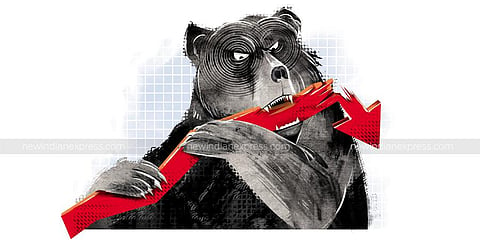

There is nothing quite like context – and a change in geographic location -- to bring home realities. This June, the Reserve Bank of India invoked images from Sri Lanka to highlight the rising risk to the state of state finances. It said, “The recent economic crisis in neighbouring Sri Lanka is a reminder of the critical importance of public debt sustainability.” The reference drew derisive, dismissive commentary. India, after all, is not Sri Lanka.
Cut to October, to the United Kingdom. The imagery and ‘critical importance of public debt sustainability’ is all too real and visible in the headlines on the chaos in Britain. The UK economy, which saw the appointment of the fourth Chancellor in four months is the live laboratory, of a crisis which threatens global financial stability.
The crux is the melding of the cause and consequence of rising inflation. Developed countries are pumping more and more money to protect their people from rising costs, even as the central banks try to draw out excess money to bring down inflation. As interest rates rise, the balance is tougher to negotiate. The cauldron of competing crises is occupying global attention and has dominated debate at the annual IMF and the World Bank meetings in Washington.
There is no let up. This week saw consumer price inflation rise higher than expected in the United States derailing theories of peak inflation. In India, too, CPI spiked to 7.41 per cent in September from 7 per cent. Central banks have but one blunt instrument to lower inflation-- and higher interest rates are triggering consequences represented by what is now called the cost of living crisis.
The spectre of risks holds lessons for India. It illuminates the need to contain the build-up of deficits and debt driven up by competitive populism. In Gujarat, the Aam Aadmi Party promises free electricity up to 300 units per month, an unemployment allowance of Rs 3000 and Rs 1000 allowance for women and a monthly stipend for new lawyers besides free health care and education. The Congress is luring voters with free electricity, farm loan waivers of Rs 3 lakh, LPG cylinder at Rs 500, Rs 4 lakh to the kin of those who died during the Covid-19 pandemic and more. The list of freebies is similar and long for voters of Himachal Pradesh.
The expansion of political intervention is not limited to poll-bound states. The government in Telangana, which initiated the idea of income support for farmers resulting in a national programme, has initiated an ambitious plan for Dalit families in the state. The Dalit Bandhu Scheme provides a one-time grant of Rs 10 lakh to families, with no conditions for collateral, to start a business. States have also wooed government employees with the promise of reinstating the old pension scheme.
Indeed the expansion of promise politics -- targeting specific voting classes, from the unemployed to the aged, across over 15 states – is visible in the expanding list of schemes and in data on fiscal conduct of states. And no political party can claim innocence. There is no disputing the distress at the bottom of the pyramid. As this column observed, the critical factor is the need to align public expenditure with a public and not political purpose.
There is also the question of affordability. The RBI report reveals that ‘the slowdown in own tax revenue, a high share of committed expenditure and rising subsidy burden’ renders the level of debt in many states unsustainable. It is instructive to note that the freebie phenomenon is expanding even as the Supreme Court is examining the issue and has set up a bench to review its 2013 judgement. While the outcome is awaited, at the very least, India will get to know the extent of interventions and their impact on essential services such as health and education.
Political impulse and urges carry a price. While India is better placed than most economies, it is scarcely immune to global inflation and slowdown. The persistence of inflation in the United States suggests the US Federal Reserve will raise interest rates further by at least 1.5 per cent. Higher rates makes the dollar stronger, renders imports makes more expensive, impacts flows into emerging economies and aggravates the cost of living. The rising cost of capital will lower the pace of growth. Already both the IMF and the World Bank estimates have trimmed 2023 growth for all major economies, including India.
History is witness to the fact that macroeconomic crises in India nearly always emerge at the intersection of fiscal and current account deficits. The rise of the US dollar has dented the value of the rupee to 82.30 per dollar, and the current account deficit is hovering at over 3.5 per cent. Already the yield on the 10-year government bond is 7.42 per cent. As the RBI is forced to respond to rate hikes in the US, the cost of money at home will impact consumption and growth.
Stability rests on effective management of debt to enable growth. The rise of freebie politics -- promises of unquantified, unallocated expenditures for securing votes – threatens the fragile state of India’s balance sheet. It is imperative for the political class to recognize the price India may end up paying for their profligacy.
Shankkar Aiyar
Author of The Gated Republic, Aadhaar:
A Biometric History of India’s 12 Digit
Revolution, and Accidental India